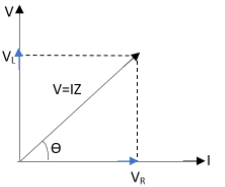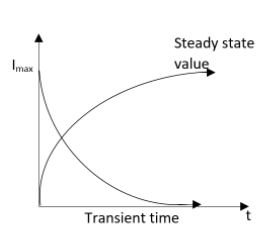
If the resistor voltage in a series RL circuit becomes less than the inductor voltage, then what will be the phase angle?
A. Decreases
B. Is not affected
C. Cannot be determined
D. Increases
Answer
555k+ views
Hint: A resistor–inductor circuit which is abbreviated as RL circuit can be otherwise called RL filter or RL network. This RL network is defined as an electric circuit consisting of resistors and inductors connected by a voltage or current source. A first-order RL circuit consists of one resistor and one inductor. This is the simplest form of RL circuit. This will help you in answering this question.
Complete answer:
Let us consider the circuit here,

Phasor diagram of RL circuit is,

The graph of RL circuit is,

As the inductor voltage gets decreased, the voltage across the resistor will be increased and therefore the current will also be increased. And finally the inductor voltage will be zero, all of the voltage source output will be across the resistor, and the current will be at its maximum value. If the resistor voltage in a series RL circuit becomes less than the inductor voltage, then the phase angle increases. In short if the resistor voltage in a series RL circuit becomes less than the inductor voltage, then the phase angle increases.
This has been mentioned as option D.
Note:
Phase angle is defined as the angle between effective resistance and effective reactance of a circuit. Here the most common value of the phase angle will be zero degrees as the reactive power would be zero. Phase angle is defined as the angle between effective resistance and effective reactance of a circuit. Phase difference can be calculated by an oscilloscope by measuring the time delay between two waveforms along with their time period.
Complete answer:
Let us consider the circuit here,

Phasor diagram of RL circuit is,

The graph of RL circuit is,

As the inductor voltage gets decreased, the voltage across the resistor will be increased and therefore the current will also be increased. And finally the inductor voltage will be zero, all of the voltage source output will be across the resistor, and the current will be at its maximum value. If the resistor voltage in a series RL circuit becomes less than the inductor voltage, then the phase angle increases. In short if the resistor voltage in a series RL circuit becomes less than the inductor voltage, then the phase angle increases.
This has been mentioned as option D.
Note:
Phase angle is defined as the angle between effective resistance and effective reactance of a circuit. Here the most common value of the phase angle will be zero degrees as the reactive power would be zero. Phase angle is defined as the angle between effective resistance and effective reactance of a circuit. Phase difference can be calculated by an oscilloscope by measuring the time delay between two waveforms along with their time period.
Recently Updated Pages
Why is there a time difference of about 5 hours between class 10 social science CBSE

In cricket, what is a "pink ball" primarily used for?

In cricket, what is the "new ball" phase?

In cricket, what is a "death over"?

What is the "Powerplay" in T20 cricket?

In cricket, what is a "super over"?

Trending doubts
What are the major means of transport Explain each class 12 social science CBSE

Which are the Top 10 Largest Countries of the World?

Draw a labelled sketch of the human eye class 12 physics CBSE

How much time does it take to bleed after eating p class 12 biology CBSE

Explain sex determination in humans with line diag class 12 biology CBSE

Explain sex determination in humans with the help of class 12 biology CBSE




